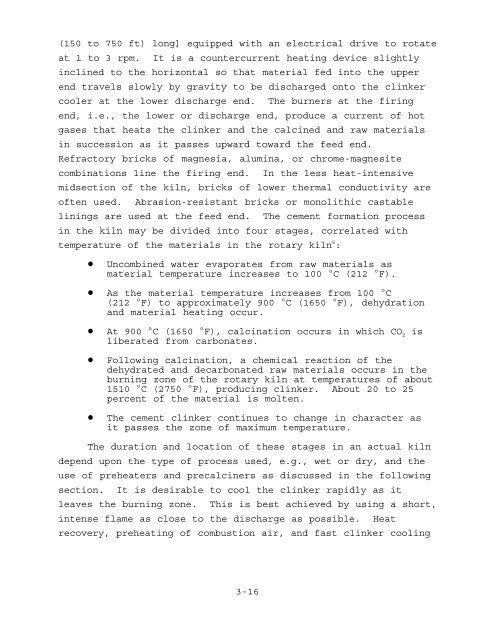NOx Emissions from Cement Mfg - US Environmental Protection ...
NOx Emissions from Cement Mfg - US Environmental Protection ...
NOx Emissions from Cement Mfg - US Environmental Protection ...
Create successful ePaper yourself
Turn your PDF publications into a flip-book with our unique Google optimized e-Paper software.
(150 to 750 ft) long] equipped with an electrical drive to rotate<br />
at 1 to 3 rpm. It is a countercurrent heating device slightly<br />
inclined to the horizontal so that material fed into the upper<br />
end travels slowly by gravity to be discharged onto the clinker<br />
cooler at the lower discharge end. The burners at the firing<br />
end, i.e., the lower or discharge end, produce a current of hot<br />
gases that heats the clinker and the calcined and raw materials<br />
in succession as it passes upward toward the feed end.<br />
Refractory bricks of magnesia, alumina, or chrome-magnesite<br />
combinations line the firing end. In the less heat-intensive<br />
midsection of the kiln, bricks of lower thermal conductivity are<br />
often used. Abrasion-resistant bricks or monolithic castable<br />
linings are used at the feed end. The cement formation process<br />
in the kiln may be divided into four stages, correlated with<br />
temperature of the materials in the rotary kiln :<br />
6<br />
! Uncombined water evaporates <strong>from</strong> raw materials as<br />
material temperature increases to 100 EC (212 EF).<br />
! As the material temperature increases <strong>from</strong> 100 EC<br />
(212 EF) to approximately 900 EC (1650 EF), dehydration<br />
and material heating occur.<br />
! At 900 EC (1650 EF), calcination occurs in which CO is<br />
2<br />
liberated <strong>from</strong> carbonates.<br />
! Following calcination, a chemical reaction of the<br />
dehydrated and decarbonated raw materials occurs in the<br />
burning zone of the rotary kiln at temperatures of about<br />
1510 EC (2750 EF), producing clinker. About 20 to 25<br />
percent of the material is molten.<br />
! The cement clinker continues to change in character as<br />
it passes the zone of maximum temperature.<br />
The duration and location of these stages in an actual kiln<br />
depend upon the type of process used, e.g., wet or dry, and the<br />
use of preheaters and precalciners as discussed in the following<br />
section. It is desirable to cool the clinker rapidly as it<br />
leaves the burning zone. This is best achieved by using a short,<br />
intense flame as close to the discharge as possible. Heat<br />
recovery, preheating of combustion air, and fast clinker cooling<br />
3-16

















